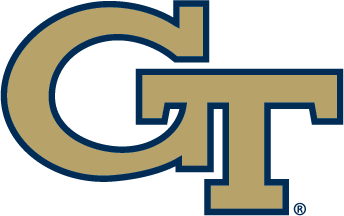Oct. 31, 2015
Georgia Tech will start the 2015-16 season with pretty much all of its players at 100 percent.
The sight of guards Marcus Georges-Hunt, Josh Heath, Corey Heyward, and Travis Jorgenson, and center Ben Lammers playing injury-free is a wonderful one for Coach Brian Gregory, but is also rewarding for assistant athletic trainer Richard Stewart. Stewart in his eighth season on The Flats helping rehab Georgia Tech men’s basketball — he also works with the men’s and women’s tennis teams — played a key role in getting those five players back on the court. He’s earned the coaching staff’s admiration.
“I’ve learned through 25 years of coaching how valuable having a great trainer is and Richard is as good as I’ve been around,” said Gregory. “He does all the stuff medically. He’s obviously top-notch in that but he has a tremendous relationship with the players. He’s very good at reading where guys are not only physically but mentally. He’s an important part of our coaching staff. You have to have the best of the best and that’s exactly what Richard is.”
STEWART: “The most rewarding thing is just being able to get these guys back from long-term serious injuries. Going throughout the entire process, seeing them be able to get back onto the court and seeing the light and the sparkle in their eyes and their faces saying, ‘I’m back,’ that’s probably the most rewarding aspect.”
Georges-Hunt, Heath, Lammers, Jorgenson and Heyward each has a unique story but all agree that Stewart is unique.
MARCUS GEORGES-HUNT- Foot
The Yellow Jackets’ captain was looking forward to leading the team into the ACC Tournament when, around three minutes into the season finale against North Carolina last March 3 at McCamish Pavilion, he fractured the fifth metatarsal bone in his right foot. The injury forced Georges-Hunt, who hadn’t missed a game in three years (he’d played 94 straight), had to miss the ACC Tournament and undergo surgery. What he needed to do next over the next several weeks may have been even more difficult. He’d have to do nothing as the bone healed, then, get used to walking, running and finally getting into basketball shape.
Stewart was there every step — and non-step — of the way. He was the older brother Marcus never had.
“Richard wants nothing but the best for you,” said Georges-Hunt. “He really doesn’t want to see us in [the training room] but if he has to see us he makes sure that we get back out there at the best of our ability. He’s like an older brother. He pushes me.”
Georges-Hunt remembered one exercise that especially pushed him.
“When I first got out of my cast he told me to walk two laps around the training room,” he said. “I wouldn’t say it was hard, but I was scared to do it. I was really hesitant because I didn’t know how my foot would react or what would happen if I took that one step and kept walking. Everything he makes me do I feel is going to make me stronger, better.”
STEWART: “You could ask the same thing to [Director of Sports Medicine Jay] Shoop or Felicia [Tucker] or Mark [Smith] or Carla [Gilson], all the others that work around here. It’s in our nature, in our DNA to not just be an athletic trainer, not just be the person that does their treatment and rehab all day. To be more than that. To help them not only grow on the court and on the field, but as people. As kids adapting in life.”
JOSH HEATH- Double Hernia
Much like Georges-Hunt, point guard Josh Heath’s injury, a double hernia, required rest. But Heath’s was a wear injury, and he was able to play through it. He’d need surgery then a couple of weeks to rest, then movement rehab, i.e., walking backwards and sideways.
Stewart patiently guided him through every move, primarily offering mental reinforcement.
“The rehab process was so simple at the beginning, so when I first started running it was a major thing,” Heath said. “I know that running sounds like it shouldn’t be the toughest thing but it was at that time. I didn’t think I was ready. He saw that I could do it, he just made me run and I just did it.
“If you’re struggling to do something, he’ll tell you to ease up or if he sees that maybe you’re a little bit stronger than you think, you just need some confidence he’ll boost your confidence as well.”
Heath played in all 31 games (four starts) last season, with a team-high 2.08 assists-to-turnovers ratio.
STEWART: “I ran track in high school, I was a sprinter, and I would always get these nagging, overuse injuries and, back then, we didn’t have an athletic trainer. I loved sports and I loved sports science and sports medicine, and I wanted to find a profession that dealt with all that. So I found a textbook one day, athletic training, researched it, saw what was in store possibly for me, did some internships and some apprenticeships and kind of fell into the profession that way.”
A 2005 graduate of Salisbury University (he has a master’s in health promotion and physical education at Virginia Tech, Stewart worked as an assistant athletic trainer for football and a graduate assistant athletic trainer for football and men’s soccer at Virginia Tech, while also working as an assistant athletic trainer for the Cologne Centurions of NFL Europe.
BEN LAMMERS- Knee
Ben Lammers was about as far behind the eight ball as he could be when he first met Stewart. He a freshman AND was still overcoming a dislocated kneecap, leaving him unable to train.
Stewart defused the potentially scary situation, putting Lammers at ease and getting him back on the court.
“He’s never intimidating,” said Lammers, whose worst injury prior to the knee was a minor groin strain in eighth grade. “When you’re coming back off a knee injury or something like that, where it takes six months to rehab, you’re in a little bit of a delicate state, so if you have a guy constantly yelling at you it can be fairly damaging. If I did something wrong, or if he didn’t think I was going hard enough in an exercise, he would get on me, but then he would also joke to get my mind off it. Rehab was really hard. I had to go through a bunch of pain. He made it a lot easier.”
Except for one machine, that is…the Monitored Rehab Systems machine, which combines weight training with video game graphics.
“It got like a video game, to where it was like the block-breaker game. You had to control the thing by pressing it,” Lammers said, adding with a laugh, “I was just really bad at the game, so he would bust me about being so bad and, obviously, encourage me. Eventually, I improved. He was always good at throwing some humor in there.”
Ben got the last laugh during the summer trip to the Bahamas, averaging 7.3 points and a team-high 8.3 rebounds in three games, hitting 58.3 percent of his shots and 80 percent from the line (8-of-10).
STEWART: “I’m a pretty laid-back guy. I try to be upbeat and optimistic. There’s very little that fazes me. You have to be that positive reinforcement for your athletes.”
Travis Jorgenson – Knee
Like Lammers, Jorgenson was injured as a freshman, but he tore the anterior cruciate ligament in his right knee in only his fourth game and missed the rest of the season.
From the first meetings, Jorgensen noticed Stewart’s caring and attention to detail.
“He asks a lot of questions, and he listens to you and listens to what you say about your body,” Jorgenson said. “He tweaks and personalizes whatever you have to do for treatment based on what you’re telling him so you can get better rather than just doing a strict structure.”
Jorgenson found Stewart was especially helpful in overcoming setbacks and keeping him motivated throughout rehab.
“When you first get out of surgery, you have a lot of internal motivation with the rehab,” he said. “But three or four months in, it’s painful and you’re tired and you have classes, and study halls or whatever. He really helps pushing you.”
Stewart was there for Jorgenson, keeping him believing even at his low points.
“It was just crazy because of where my knee was at at the time,” Jorgenson recalled. “I couldn’t even bend it a little bit, and he’s making me bend it a little further each day.”
The comforting voice was just what the Columbia, Mo., native needed to feel at home, even though home was nearly 700 miles away.
“You’re away from home, and your parents aren’t herem and your family’s not here,” he said. “You’re doing rehab with Rich every day, then you’re going to doctor’s appointments. It’s a difficult process, and he was a huge part in it. You build that trust over time and just do whatever he says.”
Last season, on a rebuilt knee Jorgenson played 30 games of the team’s 31 games, starting 27 of them. He sat only the second game of the season as a precaution due to knee soreness.
STEWART: “It’s a lot of encouragement. Especially for a guy like Ben or Travis or Corey. All of them got hurt either before they got here or right when got here to end their freshman year. They’re looking forward to coming in and playing and making an impact on a team, and you’re hurt and you’re out for a season. You just have to be there to say, ‘Hey, guys, you’re going to make it back. Yes, it’s going to be a tough road ahead of you, but at the same time you’ll be back 100 percent and you’ll be able to contribute to this team at some point. Understand, everything’s not over just because you have an injury.’”
Corey Heyward – Knee (twice!)
Corey Heyward is a cautionary tale of what can happen when you DON’T listen to Stewart.
Heyward tore his the ACL in his left knee in June, 2012, as an incoming freshman, then, in December, as he was about to begin the final stages of rehab, he took youthful enthusiasm a step too far.
“I didn’t listen. I didn’t follow the protocol that he was telling me. I tried to dunk the ball the first time I got cleared to jump, not cleared to dunk,” Heyward admitted. “Richard was so mad at me, he probably wanted to kill me the day I tore it the second time, but he stuck with me from the beginning to the end of that process the second time. He’s always going to be there, no matter how much you [get him angry]. He helps by just staying positive.
Heyward, who had the same affinity for the MRS as Lammers, came back strong. He played 32 games in 2013-14, then, last season, played in 19 games and was important coming off the bench.
“I don’t even think about my knee anymore,” he said. “I’ll jump on it all day. It just takes time. You have to listen.”
STEWART: “If I don’t have that patience, who else is going to have that patience with them? As an athletic trainer, we’re kind of like their counselor, their strength and conditioning coach, their confident. Someone to go to. I’m not going to lie. I was a little [mad] there for a couple of days but I had to backtrack and say, ‘Hey, he’s an 18-, 19-year-old kid. They make stupid mistakes, but you’ve got to believe in them. You have to be there for them.’ That’s what I try to do, be there as much as I can.”
What makes Stewart so effective is that, regardless of the different injuries and the personalities of the individuals involved, he remains the same person and has the ability to gain their complete trust.
“My trust level with him is high,” said Georges-Hunt. “Anything he asks me to do I know it’s nothing but to better me, to better my body and make my body stronger. Everything he wants me to do he’ll show me how to do it. A lot of former players come back and see Richard and that’s pretty big because they, obviously, have the same high trust in him as well.”
“I have complete trust in Rich,” said Jorgenson. “I’ve observed that he’s always looking out for what’s best for you, and he’s always trying to help us as a team and as individuals.”
Once his guys are on the court, he’ll try to help as he’s looking on at courtside.
“You can look at his actions on the bench. He has that fire in him,” said Georges-Hunt. “You can hear him. He’s always into the game. He’s always pumped. On the basketball sidelines the referee can kick you out of the game. It’s obvious who is yelling so it’s more of a calm, collected Richard, unless the game is real big and it’s real close and it’s coming towards the end.”
STEWART: “I don’t get as animated as Mike Bewley does (laughs) but I get pretty into the games. I’m with these guys 24/7/365. I might not be out there calling plays but I want to make sure we’re successful. If that’s me trying to cheer a little bit on the sidelines I’m going to do whatever it takes for us to be successful as a program.”









